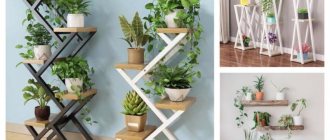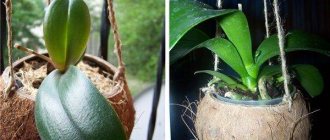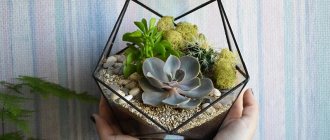Cacti and succulents are unpretentious, drought-resistant plants that thrive at home. They can go for months without watering, survive near hot radiators and require almost no care. However, immediately after purchase and then once every 1-2 years, these evergreen inhabitants of window sills still need to be replanted: the new container must correspond to the volume of overgrown roots, and the soil must have a light, porous structure. This article will help you decide which pot to plant the cactus in so that it is healthy and looks beautiful in the interior.
How to choose the right container?
How the cactus will grow, and whether it will grow at all, directly depends on the qualities of the pot: its size, the presence of drainage holes, and the material it is made of. And so that you don’t have to replant the poor thing for a long time and painfully, it is better to immediately approach the choice of a pot with all seriousness.
Dimensions
The first factor is the size of the pot. The development of the plant’s root system, and, as a consequence, the plant itself, will depend on the size.
The dimensions of the pot should be selected in proportion to the cactus and its roots:
If the roots of the cactus are tap or turnip-like, you should purchase a deep pot. In a pot that is not deep enough, the root will hit the ground and begin to rot.- For cacti with a fibrous root system, wide pots are suitable. The diameter should correspond to the size of the root.
The cactus is replanted once every 2-3 years, while increasing the size of the pot by 1-2 cm; it should always be larger than the roots by this amount. However, it is worth noting that if the growth and flowering of the succulent does not stop, then you can postpone the “moving”. What happens if you neglect the size of the pot?
- Too big. If you plant a small cactus in a pot that is too large, then after a while this will lead to its death due to excessive moisture and acidification of the soil (what soil is suitable for cacti?).
Is it possible to get a smaller pot? You can increase the level of expanded clay at the bottom, thereby reducing the soil level so that only the roots and root neck of the cactus are in the ground. - Too small. The roots of the cactus will eventually rest against the walls of the pot, which, without timely replanting, will lead to rotting of the roots and death of the plant.
Which material is better to choose?
The second factor will be the material. The two most common materials for making containers are clay and plastic. Pottery is considered traditional for growing any plant. The manufacturing material is popular due to its beneficial properties, but it also has disadvantages.
The obvious advantages include:
- Porosity.
- Resistance that allows higher species to be grown in them.
- Ability to retain shape better than plastic counterparts.
- The ability to quickly evaporate moisture.
But on the other hand:
- Heavy weight.
- Rapid evaporation leads to accelerated formation of a salt layer (white coating) on the inside of the container, which ultimately causes alkalization of the soil.
- The same evaporation forces you to water the plant more and more often (read about how to properly water a cactus here).
Plastic, called “plastic” in stores, appeared not so long ago, but has already occupied its niche. There are disposable and reusable plastic pots , depending on the price, and have the following properties.
Positive:
- Low price compared to clay.
- Light weight.
- Ease of storage and transportation.
Flaws:
- Plastic walls do not allow moisture to pass through.
Therefore, to avoid root rotting, watering should be limited. Important! For a cactus in a plastic container, you should spend no more than a third of the water that is spent on watering it in a clay container. - From the first disadvantage follows the second: the earth will dry unevenly, so the surface may be dry when there is still moisture at depth.
So what should you choose?
- For small plants, plastic is much better than clay. Due to the small size of the pot, and, consequently, the soil in it, evaporation will occur at a sufficient rate, and less frequent watering will not harm the roots.
- For larger succulents, clay is a better option. Due to its stability, a clay pot will withstand the weight of the earth and a large plant without tipping over.
Form
The third factor is form. If the dimensions depend on the type of succulent chosen, then the shape of the pot is only an aesthetic preference of the gardener. It is worth noting that square pots will take up less space , but this is the only thing that can influence the choice.
Is it possible to plant in a container without holes?
The fourth factor will be the holes in the bottom of the pot. Their presence is no less important than its size, because the holes do not allow liquid to stagnate, thereby saving the roots from rotting. A cactus cannot exist in a pot without them or with a small amount of them.
Magnetic cactus pots
Tiny live plants in containers that attach to the refrigerator and other vertical surfaces have been a real hit in recent seasons. These souvenir pots can be found in online stores, or you can make them yourself by gluing a flat magnet to a rectangular or square product. Plastic or wooden cubes that are hollow inside will be a convenient base for this kind of crafts.
b1130e8d0595645924cfbfcd1654f6bf.jpg
Photo
The photo below shows what pots are needed for growing cacti.
Distinctive features
To understand what a pot for a cactus should be, you should know the characteristics of these plants. Their usual habitat is desert areas with low humidity, so cacti do not tolerate stagnant liquid, their root system must be dry and warm. When choosing a container for growing, it is also necessary to take into account the fact that in some species it develops in width, in others - in length.
The main difference between pots for succulents and analogues familiar to gardeners is the need to ensure good drainage of the root system, which is carried out through special bottom holes. In addition, an ideally selected container will accumulate thermal energy during the day and will be able to retain it throughout the night, which is extremely important for cacti, which are indigenous to warm regions.
The flowerpot does not have drainage holes, as it serves a purely decorative function. It is permissible to grow cacti in it only if it is placed at the bottom of the drainage.
Prices in Moscow and St. Petersburg
Question price? Depends on the material, size, appearance and place of purchase:
| Pot | Price in St. Petersburg | Price in Moscow |
| "Mellange" gray 1.5 l 150 mm, ceramic | 202 rubles/piece | 198 rubles/piece |
| “Patterns” white, 14.4 l 288 mm, ceramics | 942 rubles/piece | 942 rubles/piece |
| “Jardine” terracotta 1.6 l 150 mm, plastic | 38 rubles/piece | 38 rubles/piece |
| "Jardine" gray, 13 l 350 mm, plastic | 281 rub/piece | 281 rub/piece |
How to do it yourself?
There is no desire to buy a ready-made pot, but you have an unnecessary plastic bottle on hand? You can easily make a pot for a small cactus from it.
You will need:
- Empty 2 liter bottle.
- Soldering iron.
- A can of spray paint or any other item to decorate our “vase”.
- Scissors.
Procedure:
- We cut the bottle into two parts, focusing on the size of the succulent. We use the bottom part.
- We heat up the soldering iron and use its tip to burn several small holes at the bottom of the bottle. These will be the drainage holes.
- We cover the surface with spray paint or decorate it in any other way.
Homemade products
DIY pots for various succulents have a number of advantages over purchased ones.
- Homemade flower stands look elegant and original.
- There is no need to spend money on buying an expensive vessel. In most cases, homemade pots and cache-pots are environmentally friendly and are used from scrap materials.
Making homemade coasters is easy.
Mini products made from coconut
A small succulent can be planted in a pot made from coconut shells. To do this, you need to take a coconut, carefully cut it in half, and remove the pulp from the shell. The peeled half of the nut should be given time to dry. You need to drill a couple of drainage holes in the dried coconut shell.
Coconut pots
If the coconut pot will be placed on a flat surface, then you need to make a small wooden circle that will keep the coconut pot from falling. If it is assumed that the pot will be suspended, then you need to drill more side holes in the shell for the rope. The finished coconut pot will look great in almost any interior, without requiring additional decorations.
Pumpkin pots
Pumpkin pots will look great in the interior not only in the fall, but at any time of the year. To make unusual pots, you should take a pumpkin, scrape out the pulp and seeds with a spoon. Let the pumpkin dry, after which it can be filled with a suitable soil mixture and planted with a succulent crop.
Pumpkin pots
Wooden flower pots
DIY wooden flowerpots for succulents are suitable for low-growing flowers. To create an unusual flowerpot, a log or stump is suitable. You need to cut out the core from a piece of wood. You should also sand and sand the resulting wood. Bark peelings and other irregularities must be removed.
Wooden pots
You can treat the wood with stain and then let it dry. If necessary, you can varnish the pots and paint them in the desired color. Experienced gardeners do not recommend planting succulents in the wood itself. It is better to place tiny containers in it. A wooden flat plant pot will look great in a country house or country house.
Is it permissible to use it after another plant?
Is it possible to use used pots? You can, but you must follow these rules:
- It doesn't have to be a plastic disposable potty.
- It must be washed well, all remnants of the previous plant must be removed.
- If a diseased plant grew in it, the pot should be filled with a bleach solution (10%) and left for 60 minutes.
- The dimensions must match the succulent being planted.
Many novice flower growers have questions: how to properly care for a cactus, when and how to prune, fertilize and replant it, and how to choose the best place to place it? On the pages of our website you will find answers to all your questions.
The cactus is demanding of its home; it simply will not live in a bad one. But if you try to please him, or better yet, be able to do this, he will delight everyone with his flowering for many years.
Transfer
The cactus requires replanting when the previous pot becomes too small for it. It is better to do this with the onset of spring or summer, during the period of active growth, except for flowering. Also, a recently purchased flower must be replanted and the soil replaced, but this can only be done after 10-12 days to allow it to acclimatize to the new conditions.
Note! The frequency of replanting depends on the variety, age of the cactus and the occurrence of pests.
To prepare for replanting, a few days before, you need to stop watering and spraying the plant so that the soil dries well. Then, tapping on the walls of the pot, carefully pull out the cactus using tweezers. You can also wrap the flower in several layers of paper and carefully shake it out of the pot.
After this, you need to knead the earthen lump remaining on the roots. If the substrate does not crumble easily from the roots, you can soak them in warm water.
After cleaning, the roots are carefully inspected and, if damaged parts are found, cut off. For additional prevention, the root system can be immersed in water at a temperature of 60 ºC for 15-20 minutes, then dried well for a couple of days.
Once the required pot has been selected, you can begin the transplanting process.











